Live birth rates in IVF patients with and without polycystic ovary syndrome according to serum anti-Müllerian hormone concentrations
IF 3.7
2区 医学
Q1 OBSTETRICS & GYNECOLOGY
引用次数: 0
Abstract
Research question
Is there a relationship between serum anti-Müllerian hormone (AMH) concentration and live birth rate (LBR) in patients with and without polycystic ovary syndrome (PCOS)?
Design
This retrospective study included 4631 patients aged 20–35 years who underwent their first frozen embryo transfer cycle at the First Affiliated Hospital of Zhengzhou University from June 2016 to June 2021. Participants were categorized as having or not having PCOS (PCOS group, n = 1428, and NPCOS group, n = 3203, respectively). In the two groups, AMH was categorized into subgroups 1, 2 and 3 using the 25th and 75th percentiles as cut-off lines.
Results
In the NPCOS subgroups, LBR was significantly lower in NPCOS1 than in NPCOS2 and NPCOS3 (P < 0.001). In the PCOS subgroups, LBR was significantly lower in PCOS3 than in PCOS2 (P = 0.038), with no significant difference between PCOS1 and the other subgroups. In the NPCOS and PCOS groups, the preterm birth rate increased with the increase in AMH concentration in the subgroups (P = 0.018 and P = 0.016, respectively). Multivariate regression analysis revealed that AMH was an independent factor influencing the LBR and preterm birth rate in the NPCOS and PCOS groups (P < 0.05). The threshold effect analysis indicated a positive correlation between LBR and AMH in the NPCOS group at an AMH concentration of 2.98 ng/ml or less (P < 0.001), and a negative correlation in the PCOS group at an AMH concentration higher than 7.13 ng/ml (P = 0.043). Higher AMH concentrations were positively correlated with preterm birth rate in the NPCOS (P = 0.004) and PCOS (P = 0.017) groups.
Conclusions
Serum AMH concentrations could have a clinical predictive value for LBR in young patients, both with and without PCOS.
血清抗勒氏激素浓度对有和无多囊卵巢综合征IVF患者活产率的影响。
研究问题:多囊卵巢综合征(PCOS)患者血清抗勒氏激素(AMH)浓度与活产率(LBR)之间是否存在关系?设计:本回顾性研究纳入2016年6月至2021年6月在郑州大学第一附属医院进行第一个冷冻胚胎移植周期的20-35岁患者4631例。参与者被分类为有或没有PCOS (PCOS组,n = 1428,NPCOS组,n = 3203)。在两组中,AMH以第25和75百分位为分界线分为1、2和3亚组。结果:NPCOS亚组中,NPCOS1组LBR明显低于NPCOS2和NPCOS3组(P < 0.001)。在PCOS亚组中,PCOS3的LBR明显低于PCOS2 (P = 0.038),PCOS1与其他亚组之间无显著差异。在NPCOS组和PCOS组中,早产率随AMH浓度升高而升高(P = 0.018,P = 0.016)。多因素回归分析显示,AMH是影响NPCOS组和PCOS组LBR和早产率的独立因素(P < 0.05)。阈值效应分析显示,AMH浓度为2.98 ng/ml及以下时,NPCOS组LBR与AMH呈正相关(P < 0.001), AMH浓度大于7.13 ng/ml时,PCOS组LBR与AMH呈负相关(P = 0.043)。NPCOS组(P = 0.004)和PCOS组(P = 0.017)AMH浓度升高与早产率呈正相关。结论:血清AMH浓度对有或无PCOS的年轻患者LBR具有临床预测价值。
本文章由计算机程序翻译,如有差异,请以英文原文为准。
求助全文
约1分钟内获得全文
求助全文
来源期刊

Reproductive biomedicine online
医学-妇产科学
CiteScore
7.20
自引率
7.50%
发文量
391
审稿时长
50 days
期刊介绍:
Reproductive BioMedicine Online covers the formation, growth and differentiation of the human embryo. It is intended to bring to public attention new research on biological and clinical research on human reproduction and the human embryo including relevant studies on animals. It is published by a group of scientists and clinicians working in these fields of study. Its audience comprises researchers, clinicians, practitioners, academics and patients.
Context:
The period of human embryonic growth covered is between the formation of the primordial germ cells in the fetus until mid-pregnancy. High quality research on lower animals is included if it helps to clarify the human situation. Studies progressing to birth and later are published if they have a direct bearing on events in the earlier stages of pregnancy.
 求助内容:
求助内容: 应助结果提醒方式:
应助结果提醒方式:


